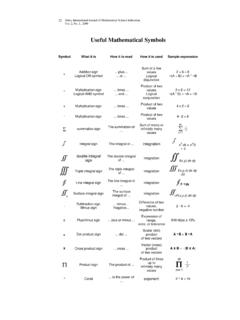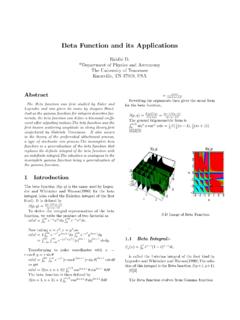Transcription of SOME APPLICATIONS OF EULERIAN GRAPHS
1 Sutra: International Journal of Mathematical Science Education Technomathematics Research Foundation Vol. 2, No. 2, 1 10, 2009 1 some APPLICATIONS OF EULERIAN GRAPHS Abdul Samad Ismail , Roslan Hasni and K. G. Subramanian School of Mathematical Sciences, Universiti Sains Malaysia,11800 Penang,Malaysia The genius Swiss Mathematician Leonhard Euler who was a prolific contributor to several areas of Mathematics is considered as the inventor of the concept of a graph . GRAPHS have proved to be very useful in modeling a variety of real-life situations in many disciplines. This article is intended for the attention of young readers, uninitiated in graph theory and gives an introductory discussion of certain well-known application problems that involve GRAPHS in their solution and in particular the role of EULERIAN GRAPHS starting from the problem of Konigsberg seven bridges to the current problem of DNA fragment assembly.
2 We also point out connections of EULERIAN circuits with drawing certain floor designs, known as kolam . Keywords: graph ; EULERIAN circuit; EULERIAN graph 1. Introduction Topics under the broad title of Discrete Mathematics are intended to provide the mathematical foundation for pursuing courses relating to computer science besides giving a mathematical background for solving problems in many application areas. graph theory is one such topic which has found use in a variety of application problems. The birth of graph theory can be attributed to the work of the famous Swiss mathematician Leonhard Euler (1707 1783) in solving the problem of Seven bridges of Konigsberg . We discuss this problem in a later section. The method used by Euler in solving this problem gave rise to the notion of graph , which essentially is a discrete structure useful for modelling relations among objects.
3 The development of the subject of graph theory has therefore been phenomenal with the subject drawing from and contributing to many other disciplines of study. In this article we discuss the notions of a graph , EULERIAN graph and certain application problems that involve EULERIAN GRAPHS , starting from the problem of Konigsberg seven bridges to the current problem of DNA fragment assembly, to draw the attention of the young researchers uninitiated in this area of study. We also bring out some connections of EULERIAN circuits with certain floor designs, known as kolam . 2. Acquaintance Problem and GRAPHS A group leader of a company was addressing in a training programme, a group of 21 newly recruited trainees of the company, who have assembled for the programme. The Abdul Samad Ismail , Roslan Hasni, 2 leader who was fond of numbers was making a remark as follows: Among the 21 trainees assembled here it could be that there are trainees who know each other, trainees who know all others, trainees who do not know each other as well as trainees who do not know anyone in the group.
4 But there will be a trainee in this group who already knows an even number (including the even number zero) of other trainees. The claim of the leader looks a little puzzling but it is true. What do we do to prove this claim? One way is to create a list, for each of the 21 persons, of other trainees in the group already known to them. The information obtained can be processed, although it could be a little cumbersome, in order to find out for each of the 21 trainees, the number of other trainees already known to them. This will reveal the truth of the claim. On the other hand, it is interesting to note that this problem could be discussed with the use of GRAPHS . We shall illustrate this with a smaller number of 7 trainees in the group, say Hussain, Johnson, Kamalesh, Khairul, Prasanna, Qadir, Ramesh. For convenience, we code their names as H,J,K1,K2,P,Q,R.
5 Suppose H knows R (even before meeting R in this training programme); J knows K1,P,Q; K1 knows J,K2,Q; K2 knows K1; P knows J; Q knows J,K1; R knows H. It is clear that H knows only one other trainee; J knows three; K1 knows three; K2 knows 1; P knows 1; Q knows 2; R knows 1. We shall call these numbers as acquaintance numbers . Thus the acquaintance numbers of H,J,K1,K2,P,Q,R are respectively 1,3,3,1,1,2,1. The claim of the leader is verified, since (at least one of them) Q knows an even number of other trainees. The situation can be modeled by a graph . For each trainee we associate a point (indicated by a small circle) in the plane. We label the points as H,J,K1,K2,P,Q,R. We join two points by a line (straight or curved) if the two trainees represented by the points know each other.
6 The resulting diagram which is an example graph , is in Figure 1. The number of lines at a point gives the acquaintance number of the corresponding person. Consider another situation as follows: Suppose H knows only R; J knows only K1; K1 knows only J; K2 knows none; P knows only Q; Q knows only P; R knows only H. Then the corresponding graph is shown in Figure 2. The acquaintance numbers are 1,1,1,0,1,1,1. Still one of these numbers namely 0 is even, again verifying the claim. Note that if the number of trainees in our discussion is 6 or 8 instead of 7 , the claim need no longer be true. For example, if there are only 6 trainees H,J,K1,K2,P,Q such that H knows only J; J knows only H; K1 knows only K2; K2 knows only K1; P knows only Q; Q knows only P, then the acquaintance numbers are 1,1,1,1,1,1, all of which are odd.
7 So, for the claim to be true the number of trainees in the group should be odd. This fact can be proved as a consequence of a basic theorem, known as Handshaking Theorem in graph theory, which we shall discuss a little later. some APPLICATIONS of EULERIAN GRAPHS 3 Thus a graph is a discrete structure that gives a representation of a finite set of objects and certain relation among some (or all) objects in the set. We shall now express the notion of a graph and certain terms related to GRAPHS in a little more rigorous way. A graph G = (V,E) consists of a finite set V of elements, called vertices (also called points or nodes) and another finite set E of pairs of elements of V of the form (u,v) (also written as uv or vu). The element (u,v) is called an edge (also called line). In a diagrammatic representation, we denote a vertex by a small circle (or by a small dot) and an edge (u,v) by a line joining the points representing the vertices u and v.
8 For example, in Figure 3, a graph is shown with 5 vertices u,v,w,x,y and 5 edges (u,x), (u,w), (x,w), (x,y), (v,y). Note that in a graph there could be more than one edge between two vertices which are referred to as multiple edges between the vertices or there could be an edge (called loop) joining a vertex with itself. Such a graph is called a multigraph. In Figure 4, a graph with multiple edges and loops is shown. The number of edges at a vertex is called the degree of the vertex. The degree of the vertex u in the graph in Figure 3 is therefore 2. The degrees of v, w, x, y are respectively 1, 2, 3, 2. If we add all these degrees we have the sum = 2+1+2+3+2 = 10. This number is twice the number of edges, namely 5. In fact this is true in any graph and the result is referred to as Handshaking Theorem.
9 Note that in the acquaintance graph in Figure 1, the number of edges is 6 and the sum of the degrees (or the acquaintance numbers) equals 1+3+3+1+1+2+1 = 12 and in Figure 2, the number of edges is 3 and the sum of the degrees equals 1+1+1+0+1+1+1 = 6. Handshaking Theorem: In any graph , the sum of the degrees of the vertices is twice the number of edges. If we denote the degree of a vertex v in a graph G = (V,E) by d(v) and if G has q edges, then this theorem can be expressed as follows: v V d(v) = 2q. Note that this theorem is a consequence of the fact that an edge (which is not a loop) is incident with two vertices, thus contributing degree one to each vertex. So while counting the degrees of vertices, such an edge will get counted twice, once at each end of the edge. (A loop is incident with a vertex two times and so contributes degree two to this vertex).
10 In a graph a vertex with even degree is called an even vertex and a vertex with odd degree as an odd vertex. The sum of the degrees of even vertices is an even number since we always have an even integer when we add any number of even integers. But only the sum of an even number of odd integers is an even integer. As a consequence of Handshaking Theorem, the number of odd vertices in a graph has to be even. In fact in a graph with an odd number of vertices, the vertices of odd degree will be even in number and so at least one vertex must have even degree. This is the reason why the claim of the Abdul Samad Ismail , Roslan Hasni, 4 group leader in the acquaintance problem with an odd number of trainees that there is at least one trainee who knows an even number of other trainees, is true. For example, in the graph with seven vertices in Figure 1, there are an even number (six) of odd vertices that correspond to trainees who know an odd number of other trainees.






